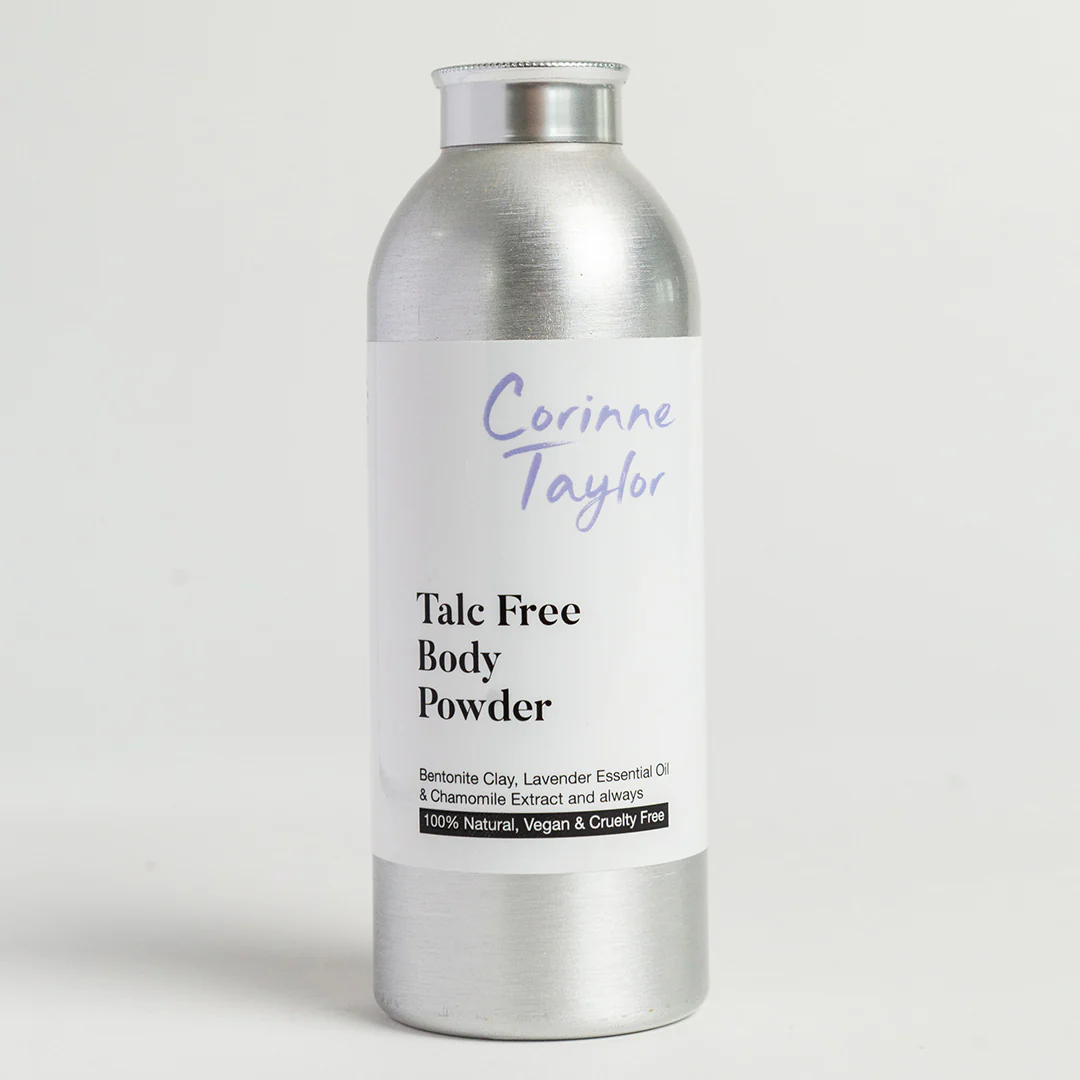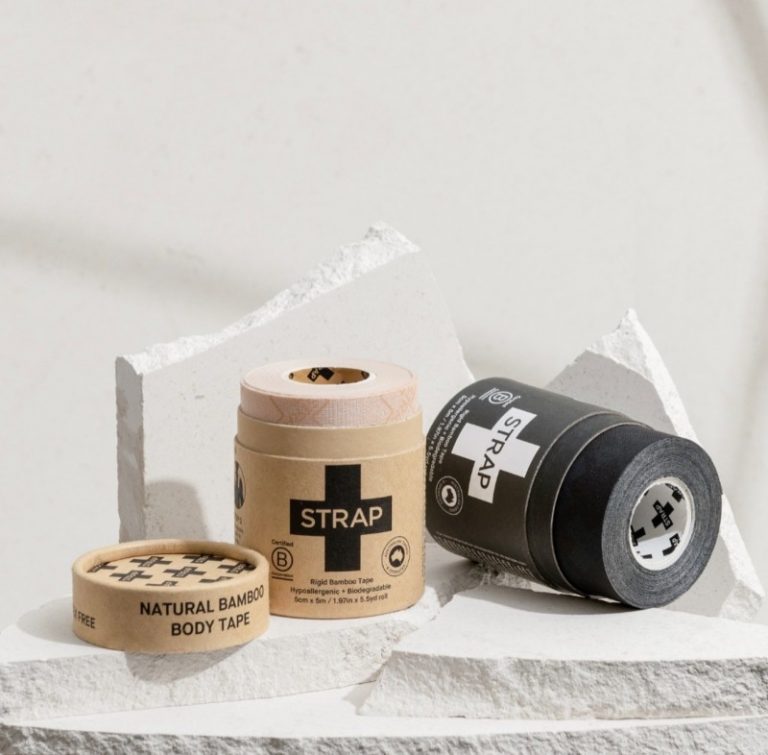
Body powder can feel like a small daily luxury, until you read the label. Many traditional powders rely on talc, and talc has long raised questions about safety. Some reports link talc to respiratory issues when inhaled. Concerns also exist about asbestos contamination in talc, since both minerals occur close together in the earth. This makes many people rethink what they dust on their skin each day.
You don’t need a body powder (you can just absorb moisture with an organic towel instead). But if you do use it, Corinne Taylor Body Powder is formulated by a qualified aromatherapist, sold in a zero waste sifting tin. Made with Bentonite clay, arrowroot and cornstarch, it contains jojoba seed oil, chamomile flower extract and lavender oil.
Avoid essential oils for pregnancy/nursing. Avoid contact with eyes. Patch test for allergies before use, and store in a cool dry place.
Talc is also found in make-up (read our post on zero waste cosmetics, to find brands that avoid talc. Wash off before pets lick you, as most contain zinc oxide.
Why Talc in Body Powders Poses Risks
Talc is a mineral used to reduce friction and absorb moisture. The concern starts with how talc is mined. Talc deposits can sit near asbestos deposits. Asbestos is a group of fibres linked to serious lung disease and certain cancers when inhaled. Not all talc contains asbestos, but contamination has been documented in some products. This risk alone is enough for many people to choose a different path.
Studies have examined talc exposure in two ways, inhalation and genital use. Inhaled powders can irritate the airways. Fine particles may reach deep into the lungs, which can be a problem for children, those with asthma, or anyone using powder in small, enclosed spaces. Researchers have also explored a possible link between long-term genital use of talc and ovarian cancer.
Traditional perfumed powders can also trigger skin issues. Synthetic fragrance blends may cause redness, itching, or rashes, especially in warm folds of skin. Some powders use additives that feel smooth at first, then dry skin out over time. If you have eczema-prone skin or sensitivity to fragrance, talc-based products may make discomfort worse.
Switching to a talc-free powder cuts these concerns. You avoid the asbestos question entirely. You also reduce the load of potential irritants, since many modern talc-free formulas rely on mild, plant-derived ingredients. The result is better skin comfort, fewer flare-ups, and a product you can use on yourself and your family with more peace of mind.
Common Health Issues Linked to Talc Use
- Ovarian cancer concerns: Some studies have reported a small increase in ovarian cancer risk with long-term talc use in the genital area. Research is mixed, but the association has shaped consumer caution and legal action in some regions.
- Lung problems: Inhaling powder can irritate the lungs. Talc dust may cause coughing or breathing discomfort. This is a bigger risk for babies, young children, and people with asthma.
- Skin reactions: Talc powders with synthetic fragrance or additives can lead to itching or rashes in sensitive users.
Not every talc source contains asbestos, but contamination risks exist. Labels seldom explain sourcing in detail, which makes it hard for buyers to judge safety. Parents and health-conscious households often choose talc-free products to remove this uncertainty from daily care.
Benefits of Going Talc-Free for Everyday Comfort
Talc-free powders have a simpler story. They use gentle starches and clays that soak up moisture without blocking pores. This supports the skin barrier, helping it stay calm and balanced. Many formulas are hypoallergenic, which is helpful if you react to synthetic perfume or heavy textures.
Other benefits include:
- Natural moisture control: Starches like arrowroot draw sweat away from skin.
- Fewer irritants: Short ingredient lists reduce the chance of flare-ups.
- Eco-friendly choices: Plant-based ingredients align with low-impact living.
- Better skin feel: Silky textures reduce friction without a cakey layer.
To spot quality talc-free options, scan for plain-language ingredients, minimal fragrance, and clear safety messaging. Choose brands that explain what each ingredient does, and avoid heavy perfumes if your skin is reactive.
Safe Alternatives to Absorb Moisture
A soft organic cotton bath sheet, patted gently over skin after bathing, dries just as well as any powder. For those who prefer a powder, choose blends made from clay, arrowroot, or oat flour. These absorb moisture without the health risks.
Natural clays and arrowroot are soft and easy on delicate skin. They don’t form harmful dust clouds when applied properly. Oatmeal baths provide another gentle solution, calming irritated or chafed skin. To use, blend oats into a fine powder, add to a warm bath, and soak for 10 to 15 minutes.
Lifestyle Changes to Prevent Chafing
Extra body weight often creates more skin folds, which raises friction and dampness. Gradual weight loss through a balanced diet and steady exercise helps reduce problem areas, bringing lasting relief from chafing.
Wearing loose-fitting, breathable clothes allows sweat to evaporate. Fabrics like cotton wick moisture away and keep skin cool. Build in regular hygiene habits—shower after activity, dry thoroughly, and check skin for signs of irritation.
Simple ways to prevent chafing:
- Stay active and maintain a healthy weight.
- Wear lightweight, loose clothing.
- Focus on drying skin well after washing.
- Keep hydrated and eat a nutrient-rich diet.
- Avoid scented products that irritate skin.
Features of Corinne Taylor’s Body Powder
Corinne Taylor’s Talc-Free Body Powder keeps things straightforward. At the heart of the formula is arrowroot powder. Arrowroot is a fine, silky starch that absorbs excess moisture and oil without smothering your skin. You get a soft, dry feel that still allows skin to breathe. This is key for comfort in warm weather or during exercise.
Kaolin clay joins arrowroot for extra absorbency. Kaolin is a gentle clay that pulls sweat and odour-causing moisture away from the skin’s surface. It does this without the tight, overly dry feel that some clays can cause. The blend helps resist chafing on inner thighs, under the bust, and in other friction-prone spots.
For scent, the powder uses light essential oils rather than heavy synthetic fragrance. The aroma is fresh and clean, not overpowering. If you avoid strong perfume, this is a welcome shift. The finish feels refined, with a soft glide that keeps clothes from sticking.
The product aims for wide skin compatibility, including sensitive types. It avoids talc and harsh fillers, which supports daily use across seasons. If certifications matter to you, check the label or the brand’s website for details on vegan status, cruelty-free policies, and ingredient sourcing. Transparency builds trust, and Corinne Taylor is known for plant-focused body care that puts skin comfort first.
Key Natural Ingredients That Make It Effective
- Arrowroot powder: Soaks up sweat and oil, leaves a light, silky finish that does not clog pores.
- Kaolin clay: Adds gentle absorbency, helps manage odour-causing moisture without drying the skin.
- Bicarbonate of soda: Offers mild odour control, used in a balanced amount to limit sensitivity.
- Botanical extracts and essential oils: Provide a clean, natural scent and soothing support where needed.
These ingredients are chosen for texture and performance. The fine grind gives a smooth brush-off feel that outperforms talc’s chalky finish. The result is comfort you can feel, from first dusting to end of day.
How It Stands Out from Other Talc-Free Options
What sets this powder apart is texture, longevity, and versatility. The blend feels finer than many starch-only powders, which helps it sit well on skin and under clothes. Users report freshness that lasts through commutes, school runs, and workouts. It works across the body, including feet, inner thighs, and underarms when you prefer a dry option to deodorant.
Value also plays a part. You use a small amount to get results, so a single bottle stretches far. The brand’s focus on plant-led formulations and thoughtful scent design rounds out the experience. Whether you want post-shower softness or post-gym dryness, it fits into daily routines without fuss.
Simple Tips for Daily Application and Best Results
- Dry your skin fully after showering.
- Shake a small amount into your palm or onto a puff.
- Pat lightly on target areas, do not rub hard.
- Use a little at a time, add more if needed.
- For sensitive spots, test a small patch first.
- If layering with lotion, let the lotion sink in, then apply powder.
- Keep a travel-sized option in your bag for gym or office use.
What Customers Love About This Talc-Free Choice
- Softness: Skin feels smooth with no gritty texture.
- No residue: Minimal transfer on clothes, even darker fabrics.
- Natural scent: Fresh and subtle, not sweet or overpowering.
- All-day comfort: Reduces chafing and keeps skin dry for hours.
- Economical use: A small amount goes a long way.
Special Concerns for Babies
Babies are particularly vulnerable to talc, as their lungs are still developing and more sensitive to airborne irritants. During nappy changes, clouds of powder often rise, making it almost impossible to avoid breathing in some dust. Inhaled talcum powder can cause coughing, wheezing, or aspiration pneumonia.
Paediatricians now strongly advise against any talc-based powders for babies. The UK and American Academy of Pediatrics both recommend steering clear, as the risks far outweigh any supposed benefits.
Gentle Options for Infants
If you use baby powder, choose a talc-free natural unscented version. Bijin is made with organic rice starch and colloidal oatmeal (good for eczema). Sprinkle onto folds of the neck, thighs and under arms to absorb moisture. Or add to a baby bath, to create a milky infusion, that’s good for itchy skin.
Here are tips for keeping babies safe at bath time:
- NHS has a good 2-minute video by a midwife, on how to safely bathe babies. Never leave babies alone for a second (even with older children).
- Do not use baby bath seats, these can quickly detach and drown babies, even in a few centimetres of water.
- Run cold water first (then add hot water, testing with your wrist or elbow). Keep your baby’s head clear of water.
- Don’t bathe straight after feeds, or if hungry or tired. Avoid baby oils in baths, due to risk of slipping.
- Don’t use cotton buds to clean baby’s ears (the cause of nearly all infections).
For nappy rash, clothe children in natural cotton (so skin can breathe) and change nappies regularly.
Green People Organic Vegan Nappy Cream is made with water-repellent berry wax, anti-inflammatory chamomile oil and hemp seed oil (rich in omega fatty acids, good for eczema-prone skin). Sold in a squeezy sugar-cane tube that’s easy to recycle.
This cream contains zinc oxide (never use near pets, as it’s toxic if licked).
Earth Conscious Baby Balm is made on the Isle of Wight, sold in a zero waste metal tin. This is packed with antioxidants and essential fatty acids, and can also be used on adults for dry patches and minor irritations. Contains organic coconut oil, almond oil, apricot kernel oil and shea butter (not for latex allergies).






